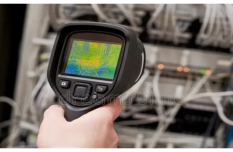Thermography Testing
Thermography testing is a crucial tool for identifying potential issues before they escalate into costly failures or safety hazards. Here's how thermography is utilized in electrical inspections:
1.Electrical components such as connections, cables, switches, and circuit breakers can become hot due to loose connections, overloading, or excessive current flow.
2.Thermography can quickly pinpoint these hotspots, indicating potential areas of concern.
1.Overheating in electrical systems is a leading cause of electrical fires.
2.By detecting hotspots early, thermography helps prevent fire hazards by allowing maintenance personnel to address issues before they escalate.
1.Thermography enables predictive maintenance by detecting problems before they cause equipment failure.
2.Regular thermographic inspections can identify deteriorating components, allowing for proactive repairs or replacements, reducing downtime and maintenance costs.
1. Inefficient electrical components generate excess heat, leading to energy wastage.
2.Thermography can identify areas of energy loss, such as poorly insulated electrical conductors or overloaded circuits, enabling improvements to energy efficiency.
1.Electrical equipment operating at high temperatures is prone to premature failure.
2.Thermography helps ensure equipment reliability by detecting overheating components and allowing timely corrective actions to be taken.
1.Many industries are subject to regulations regarding electrical safety and maintenance.
2.Thermography inspections help ensure compliance with regulatory requirements by identifying potential safety hazards and allowing for timely remediation.






